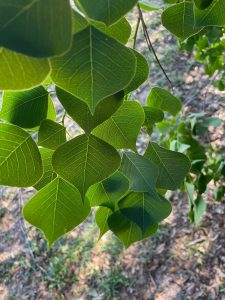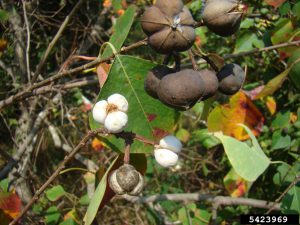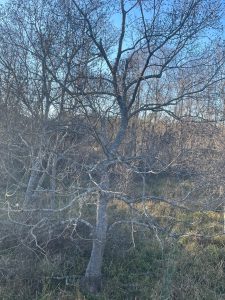
You know those things you’ve done that seemed like a great idea at the time? But maybe in hindsight were poor choices? Well, our landscapes are full of bad ideas like that.
One glaring example is the Chinese tallow, aka popcorn tree (Triadica sebifera). Blame for its initial introduction has been lain at the feet of no less important a historical character than politician and inventor Benjamin Franklin. It was quite common in his era for naturalists to collect or establish interesting new plant species that might serve a practical use for the fledgling country. While documentation shows Franklin did bring in seeds and was interested in the tree’s use for producing oils, soaps, and candles, genetic testing of the current populations has absolved the founding father of guilt for the invasive population surrounding us. Turns out, the popcorn trees that have taken over large swaths of the southeastern United States are genetically related to a batch of seeds that federal biologists imported in 1905–and not to Franklin’s from the late 1700’s.

Popcorn trees are native to China. An adaptable species with the capability to grow quickly (7-15 feet/year!) in a wide range of soil types—including freshwater wetlands—at first glance it seems relatively nondescript. But in the fall, it is incredibly beautiful. Its stingray-shaped leaves change into a rainbow of colors, from yellow and orange to deep crimson and nearly purple. Having those brilliant fall colors here in the subtropical south, where fall color is rare, was one incentive for people to plant it in the first place. For a long time, it was sold as an ornamental landscape plant and marketed as the “Florida aspen,” due to the similarity in leaf shape to the mountain-dwelling species out west.

The big problem with popcorn trees is the “popcorn” part. In late fall, the tree produces thick white seeds (up to 10,000 on a single large tree!), which look like popped kernels. The oily seeds produced in these pods are eaten by birds and dispersed throughout forests, taking root quickly. Popcorn trees are allelopathic, meaning their roots secrete chemicals that kill off rival plants, preventing anything but their own offspring to take root in the vicinity. The plant’s leaves and fruit are also toxic to humans and cattle, inducing vomiting if ingested.

Hand removal of small saplings is quite easy, but a mature tree can be stubborn. The most common recommendation is to cut it down with a chainsaw, removing all seeds and branches, and then applying a brush killer herbicide like triclopyr directly to the cut stump. Otherwise, new suckers will branch out from the stump and continue to regrow.
If you have popcorn trees but hesitate to get rid of them because of the brilliant fall color, I would highly suggest replacing your Chinese tallow with a native species like red maple, sweetgum, or sassafras. These do particularly well in wetter soils and provide deep orange and red fall color.
 7
7
